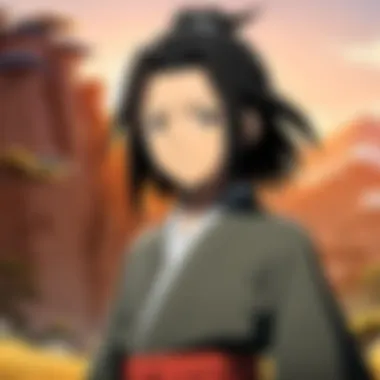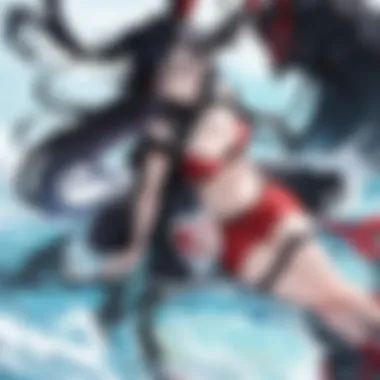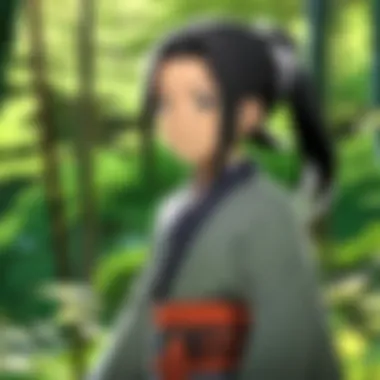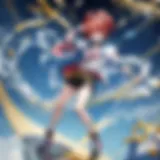Dororo: Themes of Loss, Redemption, and Humanity


Prelims to the Series
Dororo is a notable anime that blends adventure, action, and dark themes, primarily centered around loss and redemption. Originally based on a manga written by Osamu Tezuka, it first aired in 1969 and saw a remake in 2019. The story revolves around a young ronin named Hyakkimaru, who was born without his body parts due to a pact made by his father with demons. This set the stage for a unique narrative that captures the struggles of both the protagonist and the world around him.
The anime dives deeply into the psychological impact of losing one's humanity, a prevalent theme woven throughout both the manga and the animated series. This exploration is accentuated by the rich historical context of Japan, particularly during the Sengoku period, which serves as the backdrop for Hyakkimaru’s quest.
The series gained significant popularity in Japan and abroad, earning praise for its storytelling, character depth, and animation style. The 2019 adaptation particularly received acclaim for its modern approach and compelling visuals, making it a vital component of contemporary anime discussions.
"The duality of loss and redemption in Dororo resonates deeply with viewers, inviting them to reflect on their own experiences and choices."
Its reception has sparked conversations about its relevance in modern culture, contributing to the ongoing interest in anime that challenges traditional narratives and explores complex human emotions. With an engaged fan base, Dororo not only entertains but also encourages thoughtful examination of its profound themes.
Overview of Dororo
Understanding Dororo is essential for appreciating its intricate storytelling and rich character development. This anime series stands out for its ability to meld action, drama, and profound themes of loss and redemption, making it a significant work in the anime landscape. Providing a detailed overview not only sets the stage for deeper thematic exploration but also situates the series within its historical and cultural context. This section serves as an introduction, highlighting key elements that will be explored in later sections.
Historical Background
Dororo was originally a manga written by Osamu Tezuka in the late 1960s. Tezuka, known as the "God of Manga," infuses his works with profound philosophical questions and humanistic themes. The story is set in a tumultuous period in Japan, filled with social and political changes. The historical backdrop adds depth to the narrative, encompassing not just personal struggles but also wider societal conflicts. The adaptations that followed, including the 2007 anime and the more recent 2019 adaptation, brought new audiences to this classic tale while honoring its roots.
Overview of the Plot
The plot of Dororo revolves around Hyakkimaru, a ronin who, stripped of his body parts by demons, embarks on a journey to reclaim his stolen pieces. Accompanying him is Dororo, a young thief with a troubled background. Together, they face supernatural enemies while exploring the complexity of life, identity, and fate. The narrative elegantly intertwines their personal quests with broader themes of morality and humanity, serving as a vehicle for profound character development. This rich plot structure enhances its engagement with viewers, making them contemplate their own existential concerns.
Adaptations and Releases
Over the years, Dororo has seen various adaptations, each bringing its own interpretation of Tezuka's original story. The first anime aired in 1969, establishing a foundation for future adaptations. The 2007 iteration offered a modern take on the tale, while the 2019 adaptation has been particularly well-received, praised for its animation quality and character fidelity. These adaptations have allowed for renewed interest in the narrative, reaching new generations of anime enthusiasts. An appreciation of these adaptations is vital, as they reflect changing societal values and artistic capabilities while staying true to the core themes of the original work.
Character Analysis
The section on character analysis plays a crucial role in understanding the depth of Dororo. Each character embodies distinct thematic elements that contribute to the narrative's overall impact. Analyzing these characters allows for a more nuanced appreciation of the series’ exploration of loss, redemption, and human nature. Notably, character dynamics reveal how individual struggles reflect broader societal and personal conflicts. This section aims to highlight significant character arcs and the philosophical dilemmas they navigate throughout the story.
Hyakkimaru's Journey
Hyakkimaru represents the central character whose journey is laden with complex emotions and stark realities. As a child who was robbed of his body by demons, each confrontation he faces is not just a battle against these supernatural beings but also an internal struggle for identity and humanity. His quest for reclaiming his stolen body parts serves a dual purpose. It is both a literal fight for his completeness and a metaphorical exploration of what it means to be human.
The development of Hyakkimaru’s character allows viewers to engage with themes of existentialism. There are moments where he questions his own existence and experiences profound loneliness. The layers of his character provide a rich backdrop for discussions about the relationship between suffering and self-discovery. His growth from a vengeful warrior to a more compassionate individual reflects the transformative power of empathy and connection in overcoming pain.
Dororo: The Symbol of Innocence
Dororo, the titular character, serves as a stark contrast to Hyakkimaru’s dark journey. He embodies innocence and resilience in the face of adversity. His character is a beacon of hope and serves as a catalyst for Hyakkimaru’s emotional evolution. Despite the grim circumstances surrounding them, Dororo's unyielding spirit and unwavering kindness brings forth a refreshing perspective on life.


His playful demeanor masks deeper traumas and reveals the harsh realities faced by marginalized individuals in feudal Japan. Rather than succumbing to despair, he acts as a reminder of the simple joys and moral courage that can exist even in dire situations. The bond formed between Dororo and Hyakkimaru emphasizes the importance of friendship and understanding, as they both navigate a world filled with loss. This relationship ultimately unveils layers of human connection and highlights the innocence that can thrive amid chaos.
Supporting Characters
The Role of the Father
The father figure in Dororo, Daigo Kagemitsu, illustrates a complex relationship intertwined with the themes of sacrifice and betrayal. His actions set the course for the story; by making a pact with demons to gain power, he inadvertently dooms his son. This tragic decision acts as a representation of the moral failings often intrinsic to authority figures. Daigo embodies the tension between ambition and family, serving as a cautionary element within the narrative.
The key characteristic of Daigo is his duality; he is both a creator of suffering and a man caught in the web of his own desires. This makes his character a valuable subject for analysis. Understanding Daigo's motivations and the impact of his choices on Hyakkimaru allows for critical discussions on generational trauma and the weight of expectations placed on individuals. While his role might seem solely villainous, it also reflects the complexities of human desires.
The Impact of Other Allies
Other supporting characters significantly enhance the narrative richness of Dororo. Allies such as Biwamaru and Mutsu provide depth and context to Hyakkimaru and Dororo's journey. Each ally introduces unique perspectives and skills that aid the protagonists in their quest. For instance, Biwamaru’s wisdom and Mutsu's strength are pivotal; they highlight the significance of community and interdependence.
The key characteristic of these allies is their diverse motivations which create a multi-faceted view of heroism. They are not just side characters but essential components that emphasize the central themes of redemption and connection. Their interactions allow for moments of levity, deeper reflections, and underscore the value of companionship.
The unique feature of these characters is how they challenge and enrich the beliefs of Hyakkimaru and Dororo. Such dynamics can lead to revelations that propel the narrative forward. However, there is a downside; the sheer number of characters may distract from the central storyline if not properly balanced. Overall, the impact of supporting characters highlights the interconnectedness of human experience even amidst personal turmoil.
Themes Explored in Dororo
The themes explored in Dororo are vital to understanding its deeper messages and emotional resonance. The series does not simply tell a story; rather, it invites viewers to reflect on their own experiences with loss, redemption, and the forces that shape our destinies. By dissecting these themes, one can gain greater insight into the human condition depicted throughout the anime. Understanding these elements can enhance appreciation for the storytelling techniques and character development employed by its creators.
Existential Struggle
Existential struggle is a central theme in Dororo. The characters, particularly Hyakkimaru, embody the quest for identity and meaning amid suffering and adversity. Hyakkimaru’s physical and emotional battles against the demons—each representing different aspects of his past—serve as a metaphor for the human experience. The viewer is drawn into his journey, which reflects the innate desire to find purpose. This struggle resonates with audiences who may see parts of themselves in Hyakkimaru's search for wholeness.
The idea of loss is ever-present; Hyakkimaru's quest is fueled by a need to reclaim himself and confront his very existence. This raises questions about what it means to be whole and the sacrifices necessary to achieve it. By showcasing these struggles, Dororo prompts discussions about personal and collective experiences of trauma and the implications on one's identity.
Redemption and Forgiveness
Another significant theme in Dororo is redemption and forgiveness. As characters confront their past actions and the consequences of those actions, the narrative emphasizes the potential for change. Hyakkimaru, through his interactions with others, seeks to forgive those who wronged him and, in turn, seeks forgiveness for his own violent path. This interplay between redemption and forgiveness underscores the complexity of relationships and moral dilemmas.
The anime illustrates how discovering the ability to forgive can lead to healing. Characters like Dororo grapple with their own feelings of loss and betrayal. Their growth and eventual acceptance serve as reminders that redemption is not merely about erasing past mistakes but learning to live with them. This exploration of redemption confirms the notion that humanity is capable of change, making it a compelling point of discussion.
The Influence of Fate and Destiny
The tension between fate and destiny also emerges as a profound theme in Dororo. The narrative suggests that while certain events may be preordained, individuals have the power to influence their paths through actions and choices. Hyakkimaru's struggle against the demons and his attempts to reclaim his stolen body parts serve as a reflection of agency versus determinism.
The characters often face decisions that determine their futures, leading to a contemplation of how much power one truly has over their life. The theme suggests an inherent uncertainty in the choices made, prompting the audience to think about their own decisions and the idea of 'what could have been.' This duality adds layers to the plot, making it rich for analysis and interpretation.
"In exploring themes like existential struggle and redemption, Dororo transcends traditional storytelling, engaging the audience in profound reflections on life and identity."
Understanding these themes elevates the narrative of Dororo beyond mere entertainment. It urges viewers to think critically about the stories of loss, regret, and the pursuit of meaning and belonging.


Cultural Significance
The cultural significance of Dororo lies in its ability to connect with deep-rooted themes within Japanese folklore, which resonates with both historical and contemporary audiences. This anime series offers insight into the traditions, values, and beliefs that are prominent in Japan’s rich cultural tapestry. By exploring the cultural significance, viewers can appreciate how Dororo reflects its societal context while also challenging notions of fate, morality, and the intricacies of human existence.
Contextualizing within Japanese Folklore
Dororo draws extensively from Japanese folklore and myth. The character of Hyakkimaru is emblematic of the hero's journey, a common trope found in many folktales. His struggle against demons serves not only as an external battle but also symbolizes the internal struggles faced by individuals against their own demons, both figuratively and literally. By presenting these elements, the series helps to contextualize its narrative within the larger framework of Japanese myths and legends.
Additionally, the themes of loss and redemption resonate strongly in folktales, where characters often endure hardship to attain a greater understanding of themselves and their world. This connection to folklore allows viewers to see Dororo not merely as a story about a young boy and a cursed warrior but as a representation of Japan's cultural psyche and its historical narratives.
Impact on Modern Anime
The influence of Dororo extends beyond its historical context. It has shaped the landscape of modern anime in various ways, making it a notable point of reference.
Legacy of Adaptations
The legacy of adaptations is significant in the context of Dororo. The series has inspired numerous adaptations, including the 2019 anime reboot. These adaptations retain the core elements of the original story, while also modernizing the visual style and narrative pacing to suit today’s audience.
This ability to update a classic tale connects with newer generations, allowing them to engage with the source material without losing its essence. The adaptation process invites a reevaluation of the story and its themes, showcasing its relevance across decades. This interchange between old and new not only keeps the narrative alive but also enriches its legacy, encouraging discussions about the evolution of storytelling methods in anime.
Inspiration for Contemporary Works
Contemporary anime creators regularly cite Dororo as an inspiration. The themes of struggle against overwhelming odds and the quest for identity are prevalent in many modern series. These thematic elements have become a hallmark in today�’s storytelling, influencing works that delve into psychological and emotional depths similar to those found in Dororo.
Furthermore, the character development in Dororo, particularly of Hyakkimaru and Dororo, has paved the way for more complex and multifaceted protagonists in anime. This depth in character portrayal promotes a more nuanced approach to storytelling, one that resonates significantly with audiences seeking authenticity in characters and narratives.
"Incorporating traditional narratives into modern contexts can create layers of meaning that enrich the viewing experience."
The blend of ancient influences with modern storytelling techniques results in a rich tapestry of anime. Notably, Dororo serves as a crucial reference point for understanding the evolution of narratives in this medium, enhancing its significance in the cultural landscape of Japanese animation.
Artistic Elements
The artistic elements in Dororo significantly contribute to the overall narrative and emotional depth of the series. The blend of animation techniques and music not only captures the viewer's attention but also elevates the storytelling, making it more impactful. Considering these elements allows for a richer appreciation of the series, showcasing how visual artistry and sound collaborate to enhance themes of loss, redemption, and the human experience.
Animation Style and Techniques
The animation style of Dororo is distinctive and sets it apart from other works within the anime genre. The creators utilize a unique approach that combines traditional hand-drawn techniques with modern digital tools. This hybrid method not only enhances the visual appeal but also brings forth a dynamic fluidity in action scenes, capturing the intensity of battles experienced by the characters.
Comparative Analysis with Other Series
When comparing Dororo to other series, such as Attack on Titan or Demon Slayer, one key characteristic emerges: the portrayal of violence and its emotional ramifications. In Dororo, violence is not glorified; rather, it is depicted with stark realism that underscores its tragic implications. This is a beneficial choice as it delivers a profound message about the consequences of conflict, making the viewer reflect on the morality of the characters' choices.


The unique feature of the animation in Dororo is its careful attention to detail in character expressions and environmental landscapes. The emotional weight in scenes is often conveyed not just through dialogue but through subtle shifts in expressions and meticulously crafted backgrounds. While series like My Hero Academia may prioritize flamboyant action and heroics, Dororo opts for a more somber, introspective approach. This can be both a strength and a weakness; it offers depth but may alienate viewers seeking conventional excitement.
Soundtrack and Its Role in Storytelling
The soundtrack of Dororo also plays a crucial role in its narrative framework. Composed by Yugo Kanno, the music resonates strongly with the themes of the series. The haunting melodies complement the darker aspects of the story, enhancing moments of despair and introspection. Each piece is crafted to evoke specific emotions at pivotal points in the narrative.
In essence, the combination of impactful visuals and an evocative soundtrack creates an immersive experience. Together, they pull the audience into the world of Dororo, allowing them to engage with the themes on a deeper level, making the show not only an anime but a rich narrative experience.
"In Dororo, the interplay of animation and music invites viewers into a world that reflects the complexities of loss and redemption."
A focus on these artistic elements leads to a greater understanding of the influences that create an unforgettable viewing experience for fans and newcomers alike.
Critical Reception
The critical reception of Dororo plays a vital role in understanding its impact on viewers and its place within the anime landscape. This section evaluates how critics and audiences have responded to the series, shaping perceptions and influencing its overall legacy. Analyzing reviews and audience critiques helps to highlight the intricate layers of storytelling, character development, and thematic depth present in Dororo.
Reviews and Analysis
Critical reviews of Dororo reveal a mixed yet largely positive reception among experts in anime and storytelling. Many reviewers commend the series for its rich narrative which intertwines elements of horror, adventure, and historical context. The art style and animation quality receive specific praise, often compared favorably against contemporary works.
Noteworthy reviews often highlight the character of Hyakkimaru and his emotional journey. Critics often dissect how his struggles resonate with viewers, presenting a multifaceted character who embodies loss and resilience. For instance, the storytelling strategy, alternating between moments of brutality and innocence, is noted for its effectiveness in drawing the audience into a visceral experience.
Moreover, several reviews concentrate on the moral and ethical dilemmas faced by the characters. The philosophical questions posed by Hyakkimaru's quest, including the price of redemption and the nature of humanity, provide a rich ground for analysis. These layers contribute to discussions surrounding the series's broader narratorial themes, adding depth to critical engagements.
Audience Response
Audience response to Dororo has varied, yet many find it deeply impactful. Fans express appreciation for the emotional depth and complexity of the characters. The blend of historical context with mythological elements attracts a diverse viewership. Some viewers particularly resonate with Dororo, seeing her as a symbol of innocence and survival amidst chaos.
Social media platforms like Reddit and Facebook host numerous discussions about the series. Users often share personal interpretations and emotional connections, debating themes such as morality, fate, and family. These dialogues create a communal space where fans analyze their own experiences through the lens of the characters' journeys.
Additionally, the reception of Dororo can also be traced through various rating platforms. High scores on sites provide quantitative data that corroborate the positive qualitative feedback from both critics and audiences. The sustained interest over time, reflected in fan art and content creation surrounding the series, speaks to its lasting appeal.
"The journey of Hyakkimaru is a mirror that reflects our own existential struggles, making Dororo not just an anime, but a profound exploration of being human."
In summary, Dororo has not only been critically acclaimed but has also fostered an enthusiastic fanbase. This discernment from both critics and viewers highlights the anime's significance in modern storytelling, underpinning its position as an influential work in the genre.
Finale
In evaluating Dororo, it becomes evident that the series serves not only as an entertainment medium, but also as a profound exploration of various themes central to the human experience. The combination of loss, redemption, and the complexities of human nature is woven throughout the narrative. These themes resonate on many levels, making the material relevant for both contemporary society and for historical discourse. The characters’ journeys embody this struggle, bringing to light critical questions about fate, morality, and individual choices.
Final Thoughts on Dororo
Ultimately, the significance of Dororo lies in its ability to confront tough themes through relatable characters. The development of Hyakkimaru and Dororo brings an emotional depth that captivates viewers, encouraging them to reflect on their struggles and relationships. The artistic choices lend to the storytelling, enriching the audience's experience.
Moreover, the integration of cultural elements amplifies its impact. By situating Dororo within the context of Japanese folklore, the narrative unfolds with greater richness. This connection not only preserves the cultural fabric but also invites a global audience to appreciate these narratives that transcend boundaries.
"The real strength of Dororo is not in its battles, but in its ability to question what it means to truly live, love, and lose."
By assessing the interwoven elements of Dororo, viewers can appreciate not just a story unfolding, but a complex dialogue on existence itself.















